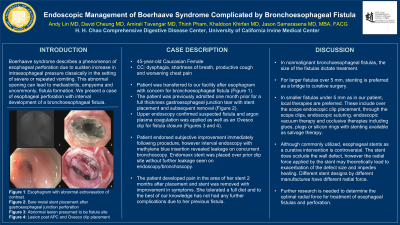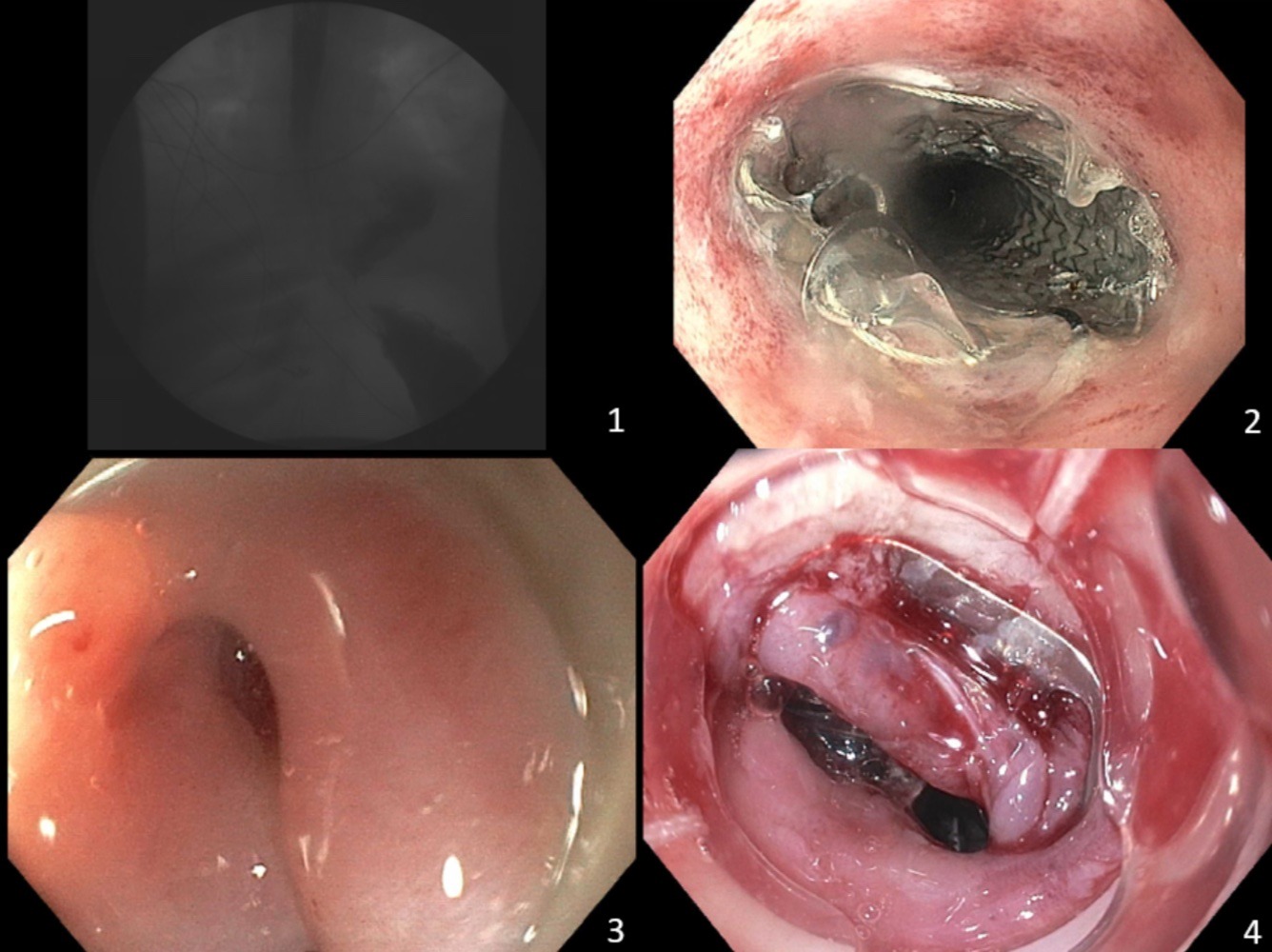Monday Poster Session
Category: Esophagus
P1935 - Endoscopic Management of Boerhaave Syndrome Complicated by Bronchoesophageal Fistula
Monday, October 23, 2023
10:30 AM - 4:15 PM PT
Location: Exhibit Hall

Has Audio
- AL
Andy Lin, MD
University of California Irvine
Orange, California
Presenting Author(s)
Andy Lin, MD1, David L. Cheung, MD2, Amirali Tavangar, MD1, Thinh Pham, 1, Peter Nguyen, MD1, Khaldoon Khirfan, MD1, Jason Samarasena, MD1
1University of California Irvine, Orange, CA; 2UC Irvine, Orange, CA
Introduction: Boerhaave syndrome describes a phenomenon of esophageal perforation due to sudden increase in intraesophageal pressure classically in the setting of severe or repeated vomiting. This abnormal opening can lead to mediastinitis, empyema and uncommonly, fistula formation. We present a case of esophageal perforation with interval development of a bronchoesophageal fistula.
Case Description/Methods: A 45-year-old female presented to an outside hospital with dysphagia, shortness of breath, productive cough and worsening chest pain and was transferred to our facility after esophagram with concern for bronchoesophageal fistula (Figure 1). The patient was previously admitted one month prior for a full thickness gastroesophageal junction tear with stent placement and subsequent removal (Figure 2). Upper endoscopy confirmed suspected fistula and argon plasma coagulation was applied as well as an over the scope clip for fistula closure (Figures 3 and 4). Patient endorsed subjective improvement immediately following procedure, however interval endoscopy with methylene blue insertion revealed leakage on concurrent bronchoscopy. 23mm x 12cm fully covered esophageal stent was placed over prior clip site without further leakage seen on endoscopy/bronchoscopy. The patient developed pain in the area of her stent 2 months after placement and stent was removed with improvement in symptoms.
Discussion: In nonmalignant bronchoesophageal fistulas, the size of the fistulas dictate treatment. For larger fistulas over 5 mm, stenting is the preferred as a bridge to curative surgery. In smaller fistulas under 5 mm as in our patient, local therapies are preferred. These include over the scope endoscopic clip placement, through the scope clips, endoscopic suturing, endoscopic vacuum therapy and occlusive therapies including glues, plugs or silicon rings with stenting available as salvage therapy. Although commonly utilized, esophageal stents as a curative intervention is controversial. The stent does occlude the wall defect, however the radial force applied by the stent may theoretically lead to exacerbation of the defect size and impedes healing. Different stent designs by different manufactures have different radial force. Further research is needed to determine the optimal radial force for treatment of esophageal fistulas and perforation.

Disclosures:
Andy Lin, MD1, David L. Cheung, MD2, Amirali Tavangar, MD1, Thinh Pham, 1, Peter Nguyen, MD1, Khaldoon Khirfan, MD1, Jason Samarasena, MD1. P1935 - Endoscopic Management of Boerhaave Syndrome Complicated by Bronchoesophageal Fistula, ACG 2023 Annual Scientific Meeting Abstracts. Vancouver, BC, Canada: American College of Gastroenterology.
1University of California Irvine, Orange, CA; 2UC Irvine, Orange, CA
Introduction: Boerhaave syndrome describes a phenomenon of esophageal perforation due to sudden increase in intraesophageal pressure classically in the setting of severe or repeated vomiting. This abnormal opening can lead to mediastinitis, empyema and uncommonly, fistula formation. We present a case of esophageal perforation with interval development of a bronchoesophageal fistula.
Case Description/Methods: A 45-year-old female presented to an outside hospital with dysphagia, shortness of breath, productive cough and worsening chest pain and was transferred to our facility after esophagram with concern for bronchoesophageal fistula (Figure 1). The patient was previously admitted one month prior for a full thickness gastroesophageal junction tear with stent placement and subsequent removal (Figure 2). Upper endoscopy confirmed suspected fistula and argon plasma coagulation was applied as well as an over the scope clip for fistula closure (Figures 3 and 4). Patient endorsed subjective improvement immediately following procedure, however interval endoscopy with methylene blue insertion revealed leakage on concurrent bronchoscopy. 23mm x 12cm fully covered esophageal stent was placed over prior clip site without further leakage seen on endoscopy/bronchoscopy. The patient developed pain in the area of her stent 2 months after placement and stent was removed with improvement in symptoms.
Discussion: In nonmalignant bronchoesophageal fistulas, the size of the fistulas dictate treatment. For larger fistulas over 5 mm, stenting is the preferred as a bridge to curative surgery. In smaller fistulas under 5 mm as in our patient, local therapies are preferred. These include over the scope endoscopic clip placement, through the scope clips, endoscopic suturing, endoscopic vacuum therapy and occlusive therapies including glues, plugs or silicon rings with stenting available as salvage therapy. Although commonly utilized, esophageal stents as a curative intervention is controversial. The stent does occlude the wall defect, however the radial force applied by the stent may theoretically lead to exacerbation of the defect size and impedes healing. Different stent designs by different manufactures have different radial force. Further research is needed to determine the optimal radial force for treatment of esophageal fistulas and perforation.

Figure: 1) Esophagram with abnormal extravasation of contrast. 2) Metal stent placement after gastroesophageal junction perforation. 3) Abnormal defect -fistula site. 4) defect post APC and over the scope clip placement.
Disclosures:
Andy Lin indicated no relevant financial relationships.
David Cheung indicated no relevant financial relationships.
Amirali Tavangar indicated no relevant financial relationships.
Thinh Pham indicated no relevant financial relationships.
Peter Nguyen indicated no relevant financial relationships.
Khaldoon Khirfan indicated no relevant financial relationships.
Jason Samarasena: Applied Medical – Advisor or Review Panel Member. Boston Scientific – Consultant. Conmed – Consultant. Cook – Educational Grant. Neptune Medical – Consultant. Olympus – Consultant. Steris – Consultant.
Andy Lin, MD1, David L. Cheung, MD2, Amirali Tavangar, MD1, Thinh Pham, 1, Peter Nguyen, MD1, Khaldoon Khirfan, MD1, Jason Samarasena, MD1. P1935 - Endoscopic Management of Boerhaave Syndrome Complicated by Bronchoesophageal Fistula, ACG 2023 Annual Scientific Meeting Abstracts. Vancouver, BC, Canada: American College of Gastroenterology.

